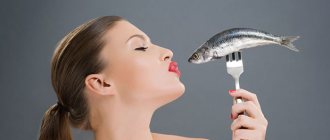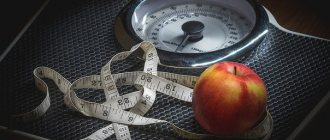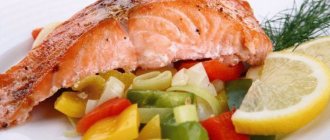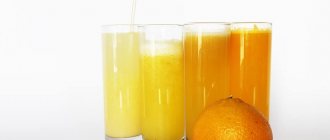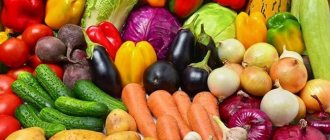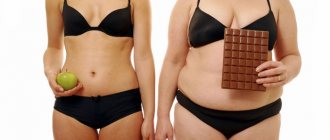Diets
31 July 2021, 17:30
- Principles of the Ornish Diet
- List of permitted and prohibited products
- Orshina diet: menu for the week
Everyone wants to be healthy and beautiful. But, unfortunately, not every diet can have a positive effect on health. As practice has shown, many methods have a negative impact on people, which is why they fail to achieve the desired result. That is why Dr. Dean Ornish has developed his own method, which is aimed not only at losing extra pounds, but also at the same time improving health.
What is the Ornish Diet?
The Ornish Diet is a plan developed by Dr. Dean Ornish, a physician, researcher and founder of the Preventive Medicine Research Institute in Sausalito, California.
The plan is essentially a low-fat lacto-ovo-vegetarian diet that focuses on plant-based ingredients such as fruits, vegetables, whole grains and legumes.
Other foods are also allowed on this meal plan, including soy products, egg whites, and limited amounts of low-fat dairy products.
According to the creator of the diet, simple changes in diet can promote weight loss and reverse the development of chronic diseases such as prostate cancer, heart disease and diabetes.
It is said to work by activating genes that promote health while reversing aging at the cellular level.
Conclusion:
The Ornish diet is a low-fat lacto-ovo-vegetarian diet that is said to promote weight loss and prevent progression of the disease.
The Dean Ornish Diet - A Low-Fat Diet for Heart Health
Users adding information to the Galya website. Removing information from the user is possible only with the consent of the editors. By adding any information to the site, the user agrees that the administration has the right not to delete it even at the request of the author.
When you die you don’t know about it, only it’s hard for others, the same thing when you’re stupid! Girls, hold on. Diet magicians!
His nutritional system is aimed at the treatment and prevention of coronary heart disease. In general, his diet is vegetarian with almost complete exclusion of fats and cholesterol. From my many years of experience, I have become convinced that special nutrition can really help people at risk of developing heart disease, as well as those who are overweight and predisposed to ischemia.
Zlobnyi sant. Some people live to eat, others eat to live, and others eat to lose weight.
Ornish diet menu
I'm trying to save money - no more than 10 rubles for food for a week. Therapeutic mud Darsonvalization.. Dopamine Eunoscopy Glands.. Fats Hormone replacement therapy Needle test..

Artificial coma Cavern.. Coumarin Laparoscope.. Lumbar puncture Magnetotherapy.. Mutation Anesthesia..
The essence of the Ornish diet
Nystagmus General blood test.. Edema Palliative care.. Pulse Rehabilitation.. Mole nevus Secretin.. Blood serum Thalamus.. Mast cells Ursolic acid Phagocytes..
Folic acid Chemotherapy.. Hospice Blood color index.. Cyanosis Strain Euthanasia.. Estrogens Poison.. Stomach ulcer.
The name Dean Ornish gained popularity due to the fact that he was a personal consultant and nutritionist for the family of former US President Bill Clinton. His diet was originally conceived for patients suffering from diseases of the cardiovascular system, since its main principle is a complete rejection of fats. Despite the fact that almost all foods contain fat, the diet can be called fat-free. The Ornish diet has several distinctive features that make it so effective.
Efficiency: kg per week Time frame: weeks or more Cost of products: rubles per day. General rules Indications Allowed foods Fully or partially restricted foods Menu Dietary routine Pros and cons Ornish diet: reviews and results Price of the diet General rules American cardiologist, Clinton family nutritionist Dean Ornish claims that even our genes can change our lifestyle.
Cons of Dr. Dean Ornish's Diet
Indications obesity; elevated cholesterol levels; diabetes mellitus type II; hypertension; prevention of prostate and breast tumors; ischemia and other problems of the cardiovascular system. Allowed products The vegetarian menu of the Ornish diet consists of: whole grain products - viscous porridge and simply boiled oatmeal, rice, millet, wheat, barley, buckwheat; greens and vegetables zucchini, eggplant, broccoli, carrots, tomatoes, cucumbers, peppers and even potatoes; Mexican red beans and navy beans, green peas, lentils; soy, for example, tofu; egg white; any berries and fruits of fruit trees with the exception of avocados.
Separation of products according to Ornish. Author-compiler: Daria Slobodyanyuk - biologist, medical journalist Specialty: Embryology, Cytology, Histology more details
Note!
The information about diets on the site is for reference and general information, collected from publicly available sources and cannot serve as a basis for making a decision about their use. Before using the diet, be sure to consult a dietitian.

How to Follow the Ornish Diet
Unlike many other fad diets, the Ornish Diet is simple and easy to follow.
There is no need to count calories or track nutrient intake, and no foods are completely off-limits as part of the diet, other than most animal products.
Meat, fish and poultry are not included in the diet, and high-fat foods such as nuts, seeds and vegetable oils are allowed only in limited quantities.
Fruits, vegetables, whole grains, legumes and soy products are key components of the Ornish diet and should make up the majority of your meals.
Egg whites and up to two servings of low-fat dairy products such as milk and yogurt are also allowed.
Healthy fats should make up about 10% of your total daily caloric intake and mostly come from natural fats in whole foods such as whole grains and legumes.
You can also eat three or fewer servings of foods such as nuts and seeds each day. However, it is important to remember that serving sizes are very small and one serving should contain less than 3 grams of fat.
Additionally, caffeinated drinks, refined carbohydrates, sugar, alcohol, and low-fat processed foods should be limited on this diet.
In addition to making changes to your diet, getting at least 30 minutes of moderate exercise every day is also recommended to optimize results.
Conclusion:
The Ornish diet includes eating mostly low-fat and plant-based foods, and limits the consumption of animal products, refined carbohydrates, high-fat foods and processed ingredients.
American development
A special nutritional method, which later received the name of its creator, was developed by cardiologist Dean Ornish.
Most Americans associate the doctor's name with President Bill Clinton. After all, it was Orshin who compiled the diet for the former head of the country and helped him quickly recover from heart surgery.
In addition, the American doctor took an honorable place as a nutritionist in the presidential family. Dean Ornish's nutritional method is suitable for both weight loss and for getting rid of/preventing diseases of the cardiovascular system.
The bottom line: down with fats and carbohydrates
This diet is a vegetarian nutrition program. She doesn't have any deadlines. The doctor says that this is not a diet at all, but a way of life. Only by changing it can you achieve the desired results. As slimming people note, in a year of such a system you can lose more than 15 extra kilos.
Dr. Ornish advises eliminating the following foods from your diet:
- red meat;
- pork;
- fatty dairy products;
- sweets, salty, smoked;
- fast food, etc.
Allowed to use:
- fruits;
- vegetables;
- legumes;
- bran;
- cereals;
- egg white;
- soy;
- low-fat dairy products.
These products (70%) should be the basis of your menu. You can eat them as much as you want without counting calories or weighing anything.
The doctor also allows moderate consumption of the following foods:
- avocado;
- nuts;
- seeds;
- chicken fillet;
- lean fish;
- corn.
These ingredients should be present in the diet very little - only 10% of the total amount of food consumed.
In addition, Dean Ornish recommends dedicating at least 30 minutes a day to physical exercise (gymnastics, yoga, stretching, cardio training, etc.).
Author's Promises
The doctor is convinced that this approach to nutrition will help overcome excess weight, even if there is a high predisposition to it. It is also possible to avoid diabetes, high blood pressure and other cardiovascular diseases.
So, for more than 30 years, an American cardiologist and part-time nutritionist conducted research, the descriptions of which he recorded in a notebook (and published them decades later).
It turned out the following:
- after 28 days of rational nutrition, patients experienced an improvement in blood flow;
- after 2 months, most people lost body weight within 5-7 kg;
- after 2 months, the heart’s ability to pump blood improves;
- after a year of diet, many patients managed to get rid of coronary artery blockage;
- after 12-18 months people normalize their weight;
- after 5 years, heart performance improves by 300%.
The research results are impressive, aren't they? Essentially, your health is in your hands.
Criticism of colleagues
Dr. Ornish's nutritional system has rocked the global medical community. Someone supported their colleague, while others criticized such a diet to the nines. Most doctors are confident that the diet on this program is unbalanced.
Too little polyunsaturated fat in the menu is fraught with harmful consequences
Doctors say that the human body cannot perform its functions normally without this important biological element
The American doctor has a different view on this. He has been practicing his diet on patients for more than 30 years and sticks to it himself. The doctor is confident that his program is an indispensable assistant for diseases of the heart and blood vessels.
Health Benefits of the Ornish Diet
The Ornish diet may be associated with several health benefits.
May help you lose weight
The Ornish Diet involves consuming nutrient-dense foods such as fruits, vegetables and plant proteins, making it a great option if you want to lose weight.
According to one study of 20 people, following the Ornish diet for 1 year resulted in an average weight loss of 3.3 kg, which was more than other popular diets such as the Atkins diet, Weight Watchers diet and the Zone diet.
Likewise, another year-long study found that 76 participants who followed the Ornish diet lost an average of 2.2 kg.
Additionally, other studies show that switching to a vegetarian diet can help you lose weight.
In one study of 74 people with type 2 diabetes, following a vegetarian diet for 6 months was significantly more effective than following a low-calorie diet at promoting fat loss.
Flexible and easy to use
Unlike other diet plans that require you to carefully count calories or track your nutrient intake, the Ornish diet requires minimal effort and is relatively easy to follow.
According to the diet's creator, other than certain animal products, no foods are completely off-limits on the plan—although some ingredients should be limited.
Even some prepared foods, such as veggie burgers or whole grain cereals, are okay in moderation as long as they contain less than 3 grams of fat per serving.
Given that the diet is not overloaded with complex rules and regulations, it is easy to follow in the long run.
Conclusion:
The Ornish diet may promote weight loss and help prevent disease. It is also more flexible and easier to follow than other diets.
The Ornish Diet: Lean Longevity and a Healthy Heart
The Ornish diet promotes longevity as it significantly increases telomerase. Telomerase is the enzyme responsible for maintaining telomere length. Telomeres are located at the ends of chromosomes that control aging. The more telomerases, the longer we live.
Finally, the Ornish diet helps you lose weight without harm to your health, although its founder did not set such goals.
Among the 25 best diets (US ranking), the Ornish diet is recognized as the best diet for the heart in coronary artery disease.
The Ornish diet is complete in composition, safe and beneficial in its effect on the cardiovascular system. There are more than enough Ornish recipes. The disadvantage of the system is that it is too strict, and sticking to a diet that is so limited in fat is not easy.
Potential harms of the Ornish diet
Although the Ornish diet is associated with some potential health benefits, there are some disadvantages to consider.
For starters, it's very low in healthy fats: less than 10% of your total daily calories come from fat.
Most health experts and regulatory agencies recommend getting about 20-35% of your total daily calories from fat to help optimize health.
Healthy fats, such as mono- and polyunsaturated fatty acids, may protect against heart disease, reduce inflammation, support brain function, and promote healthy growth and development.
It's also important to remember that eliminating meat and certain animal products from your diet may increase your risk of nutritional deficiencies.
In fact, research shows that vegetarian diets tend to be lower in important nutrients such as protein, calcium, vitamin B12 and zinc.
Monitoring your intake of these key vitamins and minerals and consuming a variety of nutrient-dense fruits, vegetables, whole grains and legumes can ensure that you can meet your needs while following the Ornish diet.
To prevent nutritional deficiencies, you can also take a multivitamin, which can help fill gaps in your diet.
Conclusion:
The Ornish diet is very low in healthy fats and requires careful planning to prevent nutritional deficiencies.
Reversing heart disease?
The Ornish diet has many benefits. But she became famous due to the fact that she proved phenomenal benefits for the heart.
Considering how complex and challenging the goal is, you may only be at the very end of the healthy spectrum when it comes to food choices. If you really want to reverse heart disease, you have no wiggle room on products . Be prepared for a full-fledged fast, for a long time, and perhaps forever.
In practice, this means that you can only allow yourself 10% of your daily calories from fat (which is only 15-25 grams of fat). Nuts, seeds, avocados, olives, and vegetable oils are not recommended, since all of these products contain fats. Most foods with cholesterol, refined carbohydrates, caffeine and almost all animal products, except egg whites and one cup of skim milk or yogurt several times a week, are prohibited. Spicy seasonings are also not recommended.
The main goal is the reversal of coronary heart disease, and it is up to you to decide whether it is worth the dietary restrictions.
It was Dr. Ornish who proved that reversion is possible only by changing lifestyle and diet. Several randomized studies have been conducted, according to which a group of people practicing the Ornish diet not only stopped the progression of atherosclerosis, but also actually experienced regression of coronary artery stenosis.
The results of non-surgical and drug-free (without statins) treatment of atherosclerosis are impressive and encouraging. Within a year, angina attacks stop almost completely; after 5 years, this result is maintained, and the arteries look the same as after stenting surgery.
Some facts . In a 1990 study that lasted a year, 28 patients practiced the Ornish diet, and 20 patients followed the usual therapeutic diet for heart disease (limiting fat to 30% of calories and cholesterol to 200-300 mg per day). After a year, patients in the Ornish group were diagnosed significant overall regression of atherosclerosis of the coronary arteries (according to quantitative coronary arteriography), while in the control group atherosclerosis progressed. Patients in Ornish's group achieved near or complete freedom from angina (chest pain), likely due to increased blood flow to the heart. Studies conducted in 1992 and 1995 used other diagnostic procedures to measure the progress and regression of atherosclerosis and also showed the effectiveness of the Ornish program. It is interesting to note that in each of the studies, the degree of regression of atherosclerosis was directly related to the degree of lifestyle changes. Small lifestyle changes slowed the development of IHD, but a complete lifestyle change reversed the disease or, at least, stopped the pathological process.
What foods to eat and what to avoid
The Ornish Diet is a lacto-ovo vegetarian diet that encourages the consumption of a variety of whole foods, including fruits, vegetables and legumes.
Foods to eat
Here are some foods you can try as part of the Ornish Diet:
- Fruits : apples, bananas, oranges, kiwi, grapefruit, berries, pomegranate, melons, pears, apricots
- Vegetables : broccoli, cauliflower, cabbage, peppers, garlic, onions, spinach, zucchini
- Legumes : beans, chickpeas, lentils, black beans, lima beans, pinto beans
- Whole grains : quinoa, amaranth, buckwheat, barley, spelt, brown rice, oats
- Protein sources : tempeh, tofu, egg whites
- Herbs and spices : garlic, cumin, turmeric, coriander, cilantro, parsley, cinnamon, nutmeg
Products whose consumption should be limited
The following foods are also allowed in limited quantities on the Ornish diet:
- Nuts and seeds (3 or fewer small servings per day) : walnuts, almonds, cashews, pecans, pumpkin seeds, chia seeds, flax seeds
- Low-fat processed foods : whole grain cereals, whole grain crackers, veggie burgers
- Caffeinated beverages : up to one cup of coffee or two cups of black tea/decaffeinated coffee per day
- Dairy products (2 or fewer servings per day) : low-fat yogurt, skim milk
- Fats : olive oil, avocado, coconut oil, butter, vegetable oil, olives
- Refined carbohydrates (2 or fewer servings per day) : pasta, crackers, cookies, white bread, pancakes, flour tortillas, white rice, honey, agave, brown sugar, white sugar
- Alcohol (up to 1 serving per day) : wine, beer, spirits
- Processed foods : high-fat processed foods, baked goods, fast food, potato chips, pretzels
Foods to Avoid
Here are some of the foods to avoid on the Ornish diet:
- Meat : beef, lamb, goat, veal
- Seafood : salmon, mackerel, tuna, anchovies, sardines, shrimp, crayfish
- Poultry : chicken, turkey, goose, duck
- Egg yolks
Conclusion:
Fruits, vegetables, legumes, whole grains and plant sources of protein are encouraged on the Ornish diet. Meat, fish and poultry are prohibited, while high-fat ingredients, refined carbohydrates and processed foods should be limited.
Prohibited and permitted products
By following the Ornish diet, you will have to completely forget about the existence of cutlets and steaks.
And also give up products that are white: buns, salt, sugar, rice, pasta made from premium flour. Strictly prohibited products include:
- meat and fish in all types;
- oils (vegetable and butter), fats, mayonnaise;
- cheese and all dairy products starting from 0.5 percent fat;
- egg yolk;
- nuts and seeds;
- olives, olives, avocados;
- alcoholic drinks.
Allowed in moderation:
- low-fat dairy products, including cottage cheese and sour cream;
- egg whites;
- crackers;
- unsweetened corn flakes.
Allowed in unlimited quantities:
- legumes: beans, beans, lentils, soybeans;
- grains: pearl barley, buckwheat, millet, oats, wheat;
- fruits and berries: apricot, watermelon, banana (note that other diets exclude banana from the list), pear, apple, pineapple, etc.
- vegetables: potatoes, zucchini, cabbage of all types, lettuce, mushrooms, eggplant, tomatoes.
Sample menu
Here is a sample 3-day menu for the Ornish diet.
1 day
- Breakfast : tofu with tomatoes, onions, garlic and peppers
- Lunch : Brown rice with black beans and steamed broccoli
- Dinner : Vegetarian lentil stew with roasted Brussels sprouts
Day 2
- Breakfast : egg omelette with mixed vegetables
- Lunch : bell pepper stuffed with beans, bulgur, tomatoes, onions, cabbage and spinach
- Dinner : Chickpea curry with couscous and salad
Day 3
- Breakfast : Oatmeal with strawberries, blueberries and cinnamon
- Lunch : Zucchini noodles with pesto and cannellini bean meatballs
- Dinner : Teriyaki tempeh with quinoa and roasted vegetables
Conclusion:
The menu above provides some ideas to include in the Ornish diet.
Orshina diet: menu for the week
Constant counting according to the Ornish system creates inconvenience in everyday life . In addition, you will have to eat more at home . The fact is that catering does not provide a menu with the correct composition. Canteens, cafes and restaurants are designed exclusively for the mass consumer.
To make life easier for patients, Dr. Ornish has compiled a sample menu for one week:
- Low-fat yogurt with bran, fresh berries, low-fat cottage cheese, baked potatoes with vegetables, apricots, apples.
- Rice porridge with water, herbal tea, low-fat kefir, stewed beans with mushrooms, fresh orange juice, green tea with bread, fresh berries.
- Vegetable pancakes, herbal tea, broccoli soup with carrots, low-fat yogurt, cottage cheese with cookies, stewed cabbage, fresh berries.
- Muesli with berries, low-fat kefir, cream soup with mushrooms, vegetable salad, fruit smoothie, vinaigrette, eggplant.
- Oatmeal with berries, fresh fruit, mashed potatoes, vegetable stew, low-fat fermented baked milk, cookies (necessarily dietary), pea soup, vegetable salad.
- Low-fat cottage cheese (possibly with honey), cookies, baked potatoes with mushrooms, omelette of eggs and vegetables, fresh fruit.
- Cottage cheese casserole, vegetable cutlets, cheesecakes, potato soup with mushrooms, fresh berries, vegetable smoothie.

As you can see, simple recipes are used to prepare dietary dishes . According to reviews from those who have lost weight, the Ornish diet has an effective effect on the body. Thanks to fractional meals, there is no feeling of hunger, which subsequently does not lead to overeating . As a result, you can lose about 5-7 kg.
So, the Ornish diet is an effective weight loss method that suits everyone. This method is especially effective for cores. Thanks to the diet, you can lose extra pounds, improve your metabolism and relieve stress on your heart.
Summarize
The Ornish diet is a low-fat lacto-ovo vegetarian diet that is said to provide significant health benefits.
In addition to its flexibility and simplicity, some research suggests that the Ornish diet may help you lose weight and protect against chronic disease.
However, it is also very low in healthy fats and may lack certain vitamins and minerals, which can increase the risk of nutritional deficiencies.
So, if you want to try the Dean Ornish diet, be sure to plan it carefully to avoid negative health consequences.
Take the test and find out your ideal way to lose weight!

Take the test
In the United States, Dean Ornish is a very popular personality. After all, it was he who discovered a way to expand the lumen of blocked heart vessels without an expensive operation, but only with the help of diet.
- The Ornish diet was the one that helped former US President Bill Clinton, who had already undergone several angioplasty operations, bring his blood vessels back to normal and at the same time lose 11 kg.
And the good Doctor Ornish does not limit the amount of food you eat - you can eat as much as you want. The book “Eat More and Lose Weight” instantly became a bestseller in America, and the nutritional method itself has been at the top of dietary ratings for several years. But in Russia there are few followers of the “American Lent” (as this diet is jokingly called). In any case, on forums on the Internet, where those losing weight usually share with each other their experiences of “sitting” on a variety of diets, it is difficult to find positive reviews about the Ornish diet.
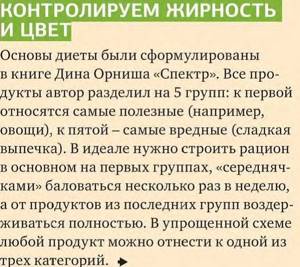
What scares off our people, who usually bravely undertake any experiment? Who don’t care about “Dukan”, and “Protasov”, and “six petals”, and indeed any hardships - just to quickly achieve the desired harmony?
- Ornish Diet - According to Dean Ornish, our main enemy is fat.
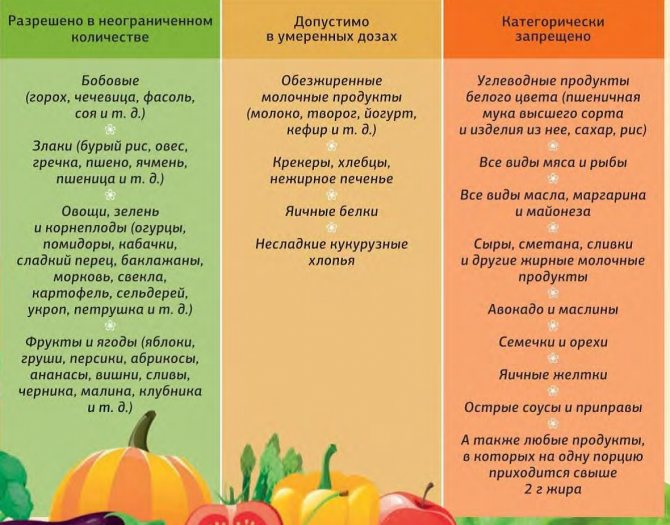
Fat has earned this reputation for a reason: it is the highest calorie nutrient (9 kcal per 1 g). Therefore, it is due to excess fat that it is easiest to gain excess weight, and with it, get all the associated diseases - including cardiovascular diseases. By eliminating fat, we reduce the risk of vascular diseases, and at the same time we automatically control the caloric content of the diet (therefore, there is no need to count calories on the Ornish diet) and stimulate the body to release accumulated fat reserves. The second pitfall of our diet is simple carbohydrates. They cause blood sugar levels to rise, the body produces more insulin, sugar is quickly absorbed and its excess immediately turns into fat. And this threatens not only obesity, but also atherosclerosis. Therefore, Dr. Ornish recommends paying attention to the composition and color of food. Products containing more than 2 grams of fat per serving are prohibited. Refined sugar, premium flour and white rice are also prohibited: white color is an indicator of an excess of simple carbohydrates! But whole grain pasta, cane sugar and brown rice are already possible. Although, of course, it is still better to add sugar, even cane sugar, to a minimum. Perhaps Dr. Ornish would eliminate even more fat from the diet of his patients. However, this is impossible: fats, at least in small quantities, are found in almost any product. The Ornish diet - those losing weight “according to Ornish” get approximately 10% of their calories from fat. Proteins account for about 20% of total calories. According to medical standards, “fat” calories should make up 20% of the diet, or even a little more, “protein” - about 30%, and “carbohydrate” - 50%. The disproportion is obvious. The lack of protein in the Ornish diet is a consequence of the exclusion of fat. Many foods - meat, fish, cheese, nuts - contain both protein and fat. So, in the name of reducing fat, figuratively speaking, you have to exclude part of the protein. But it is quite difficult to reach the norm with legumes, low-fat milk and egg whites alone. You can, of course, within the limits of what is permitted, indulge in low-fat cottage cheese and yogurt - but there are no completely low-fat dairy products, and according to the rules of the diet, any food containing more than 2 g of fat per serving is prohibited. With such a restriction, how much will it be possible to eat even the most low-fat cottage cheese? In some ways, following the Ornish diet is more difficult than being a vegan: they have the help of nuts, an excellent source of protein and “good” fat. This product is not available to followers of Ornicheanism. So the basis of nutrition is carbohydrates, mainly complex ones: 70% of calories enter the body from them. And in order to lose a noticeable amount of weight, you will have to stick to this diet for quite a long time. It is the rigor and long-term nature of the project that prevents many people losing weight from accepting the Ornish diet as a guide to action. Therefore, before you start following this diet, think about how long you can last in this regime?
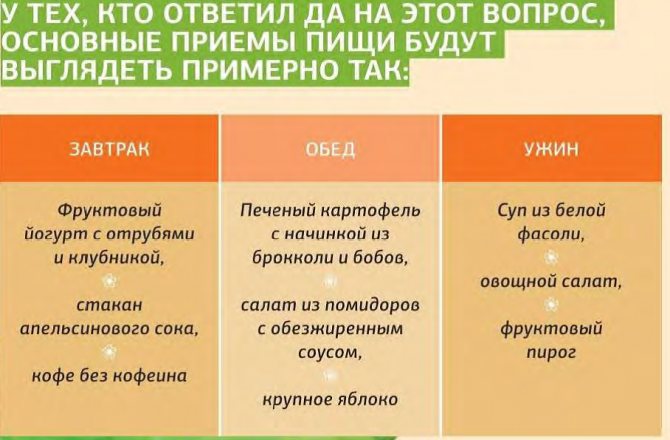
The amount of food is not limited by the diet: portions can be of any size. In addition, snacks are allowed between meals. You can eat even at night - the main thing is that all foods consumed are allowed. And on the Internet you can find a huge number of different dishes invented by the followers of Dean Ornish. However, the diet itself is not everything. Like many other nutritional systems, Dean Ornish’s health regimen also includes fitness: aerobic exercise is best, as well as practices that help combat stress and find inner harmony: yoga and meditation, deep breathing. After all, your emotional state is also extremely important for health and weight loss. Live calmly, try to see the good in everything, communicate only with people you like - this will make it easier to endure the diet. Dean Ornish himself claims that you can eat this way indefinitely. Although the diet was developed primarily for the prevention of cardiovascular diseases, losing weight on it is quite possible: Dr. Ornish's patients lose an average of 12-14 kg per year. This, one must assume, is another reason for the distrust of Russian people losing weight in this diet. After all, we want to lose weight as quickly as possible! And although 12 kg is a lot, however, for example, the “antipode” of the Ornish diet - the Atkins protein diet - allows you to achieve the same result in a much shorter time. On the other hand, when switching from a protein diet to a regular diet rich in carbohydrates, the lost kilograms immediately return. And the result of losing weight on a carbohydrate diet can be much more stable. So the choice is yours: is it better to slowly lose 12 kg or quickly get rid of 20 and immediately gain 15 back?
EXPERT COMMENTS Ekaterina Alexandrova, endonrinologist, nutritionist
— And to this diet I would add fatty fish as a source of additional protein and omega-3 peaceful acids 3-4 times a week and 1 tbsp daily. l. extra virgin olive oil. Also, it is unwise to eat too much fruit. This is a source of fast carbohydrates; when absorbed and entering the bloodstream, they stimulate the release of insulin, raise blood sugar levels and are easily stored as fat. The amount of fruit should be limited to 200 g per day (or 1 glass of juice), and eat them only in the first half of the day.
If you want to lose weight without harming your health, then a clip with nanocoating for weight loss is designed for this purpose.

Due to the effect of weak electromagnetic oscillations on points on the ear, known in acupuncture, the feeling of hunger is significantly reduced and you can freely regulate the amount of food, and metabolism also increases, the activity of the endocrine, digestive and other systems is normalized.
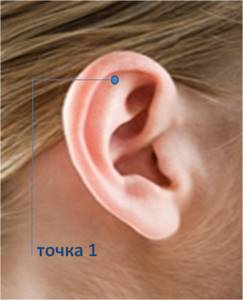
In fact, you have a personal acupuncturist in your home, but you don’t have to go anywhere, and you don’t have to pay for sessions either. By choosing the areas of influence of the ear clip, you can, in addition to losing weight, solve many other problems to improve your health. Well, the better your health, the greater your chances of not only making your figure attractive, but also maintaining it for many years. At the same time, the effectiveness of the clip is higher than acupuncture due to the resonance effects in the body, which are caused by exposure to weak electromagnetic oscillations. The AS clip with nanocoating can be ordered cash on delivery directly on the website and in the online store of AS products for the health of your home and garden.
C.O.D
The cost of the clip is 990 rubles, plus delivery by Russian Post is 290 rubles. Only 1280 rubles. Payment is made at Russian Post upon receipt.
How does it work?
The Ornish Diet works in a very systematic manner to provide numerous health benefits and aid in weight loss. She emphasizes nutrition, stress management, exercise, and emotional support to prevent or eliminate chronic disease and lose weight.
Food classification
Dr. Ornish wrote a book called Spectrum, which was the basis of 35 years of scientific research. In this book, he classifies foods into five groups. The corresponding groups included various foods, ranging from healthy (first group) to the least healthy (fifth group). The spectrum also describes ways to use products to achieve specific goals, i.e. weight loss, preventing or treating diabetes or heart disease, lowering blood pressure and cholesterol, and so on.
Limiting fat intake
Like most other diets, the Ornish Diet is also based on the premise that eating fewer calories from fat helps us lose weight and maintain a healthy heart. This approach was called Dean Ornish's low-fat diet . Fats contain more calories than carbohydrates. A gram of fat contains 9 calories, while carbohydrates and protein contain only 4 calories. Reducing your fat intake will mean lowering your calorie intake. Consuming more fruits and vegetables from the diet makes people less likely to overeat.
Exercises
The diet advises engaging in aerobic activity and strength training to stay in shape. Regular exercise improves blood flow and allows us to lose weight. It is advisable to exercise for at least 30 minutes, five times a week, or 60 minutes at least three times a week.
Stress management
Reducing stress is an equally important part of the diet. To do this, you can try deep breathing, yoga and other forms of meditation.
Emotional support
Emotional support also makes us feel happier and less likely to overeat out of anger and frustration. We need to spend time with those we love and respect. This can greatly impact our health in a positive way.
Atkins diet
The nutrition system was created by the famous cardiologist Robert C. Atkins back in 1960. It consists of several phases. The diet is aimed at ridding a person of bad eating habits and teaching him to eat properly.
The essence of the diet
A person losing weight will not have to calculate kilocalories and control the volume of food eaten. You will need to count the grams of net carbs minus fiber.
The power system consists of 4 phases:
- The first phase is strict.
It should last 14 days. During this period it will take about 4 kg. The amount of carbohydrates is reduced to 20 g per day. You need to get about 15 g from vegetables. A person should eat chicken, fish, seafood, cheeses, and eggs. At the same time, they refuse fruits, sweets, pasta, cereals and nuts. Alcoholic drinks are prohibited. A prerequisite is compliance with the drinking regime. You need to drink at least 2 liters of water per day.
- Second phase
suggests consuming 15 g of carbohydrates per day. Their source should be vegetables. Sugar is prohibited. During this period, nuts, berries, and seeds are introduced into the menu. The weight will continue to come off. The transition to the next phase is possible after losing 4.5 kg.
- Third phase
involves a return to previously prohibited food. A person can eat fruits, vegetables containing starch, and whole grains. Up to 25 g of carbohydrates are allowed per day. However, if weight gain occurs, then it is necessary to reduce their amount to 20 g. The third period should continue until the person reaches his ideal weight.
- Fourth phase
lasts throughout life. You can eat any food, but without violating the basic principles developed by Atkins. If the arrow on the scale goes up again, then you need to repeat phase 3.
The scientific basis of the diet
At Stanford University, 4 diets were studied: Atkins, Ornish, “Zones” and the low-fat LEARN diet. The experiment was carried out in 2007. People who followed the Atkins diet for a year lost 4.7 kg. [1]
Results of other diets for the specified period:
- Minus 2.6 kg on the LEARN diet.
- Minus 2.2 kg on the Ornish diet.
- Minus 1.6 kg on the Zone diet.
Low carbohydrate nutrition systems work. This has been confirmed by numerous experiments. Just recently, a review of 6 studies found that low-glycemic diets allowed you to burn 1 kg more than other diets (average data). Such nutritional systems are good for health, as they make it possible to get rid of fat deposits and normalize lipid metabolism in the body.
Another study suggests that a low-glycemic, high-protein diet helps maintain stable body weight over time.
Possible harm
In the article Atkins Diet: What's behind the claims? The Mayo Clinic website warns that a diet that drastically reduces carbohydrates may have the following side effects: [6]
- The appearance of headaches and dizziness.
- Increased weakness.
- Retention of stool.
This nutritional system should not be practiced by people with diseases of the urinary system, pregnant or lactating women. It is prohibited for persons engaged in heavy physical labor.
Read more: Atkins diet: menu, pros and cons
Fat Misconceptions and Diet Disadvantages
Many people perceive fatty foods as an absolute evil. After all, its use causes disruption of vascular conductivity, leading to heart disease, as well as excess weight, which can cause many health problems.
In fact, fat is necessary in reasonable quantities. Its derivatives are acids involved in the synthesis of hormones. Fat is needed to maintain healthy cells; without it, brain activity, proper functioning of the heart and nervous system are impossible. A deficiency of the substance leads to the fact that some vitamins and microelements are not absorbed.
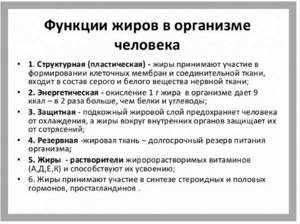
In this regard, you should not see only advantages in low-fat diets; they also have disadvantages:
- lead to vitamin deficiency;
- cause gynecological problems;
- cause deterioration of the condition of the skin, nails and hair;
- provoke nervous disorders;
- the food doesn't taste good.
Therefore, you cannot adhere to this method of eating for more than 2 - 4 weeks.
We recommend reading about the diet based on your body type. You will learn about body types, foods and sports recommended for losing weight for a certain type. And here is more information about the Pevzner diet.
Excess weight is fat. But there is no need to get rid of it using too radical methods. A low-fat diet can be followed for a short period of time to jumpstart weight loss. And then it is better to switch to a more rational diet and combine it with sports.
Vegan diet
The world learned the concept of “vegan” in 1944. At this time, several adherents of vegetarianism united and created the Vegan Society. People who join it completely exclude any meat and dairy products from their diet.
What is the essence of the diet?
A vegan diet involves avoiding meat, poultry, seafood, eggs, and dairy products. Whey, casein and gelatin should not be consumed.
Plant foods can be eaten in unlimited quantities. The menu is based on fruits, vegetables, legumes, seeds, nuts. You can eat tofu, coconut and almond milk.
The scientific basis of the diet
The vegan diet has repeatedly become the object of close attention of scientists. In 2013, it was found that it actually helps with weight loss. This was proven in a randomized scientific experiment. Over 4.5 months, the vegans taking part lost 4.3 kg. In addition, their blood sugar and cholesterol levels decreased. The weight of the control group was 0.1 kg. [10]
Similar results were obtained by scientists in 2005. The study lasted 2 weeks. During this time, people who stopped eating animal products lost 5.8 kg. The control group followed the NCEP diet. It involves replacing saturated fats with carbohydrates. Over 14 days, their average weight was 3.8 kg. In addition to weight loss, vegans experienced a significant reduction in waist size. [9]
Another study was conducted in 2007. It confirmed that a vegan diet really helps you lose weight. The experiment lasted for 2 years. In the first year, vegans lost 4.9 kg, and women on the NCEP diet lost 1.8 kg. According to the results of 2 years, the weight in the vegan group was 3.1 kg, and in the NCEP group - 0.8 kg. [3]
In 2015, scientists compared 5 diets:
- Vegan.
- Vegetarian.
- Pescetarian (you can eat fish and seafood).
- Semi-vegetarian (only red meat is prohibited).
- Non-vegetarian.
Over six months, vegans lost about 7.5% of their original body weight. This plumb line exceeded the results of other diets. [eleven]
Possible harm
A vegan diet can be harmful to health, as the person following it does not receive enough vitamin B12. It is found in products of animal origin, and its deficiency threatens the development of anemia, chronic fatigue syndrome and diseases of the nervous system.
A 2015 study found that a lack of vitamin B12 significantly increases the risk of heart attacks and strokes. Therefore, all vegans need to take this substance in the form of dietary supplements. [12]
There is no need to worry about protein deficiency. If the menu is compiled correctly, then plant foods will provide the body with protein.
